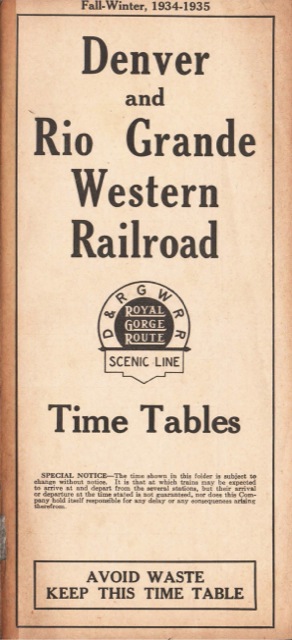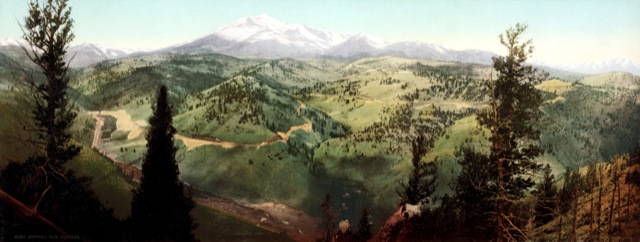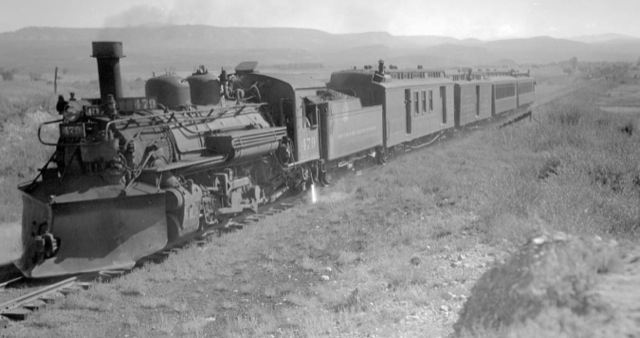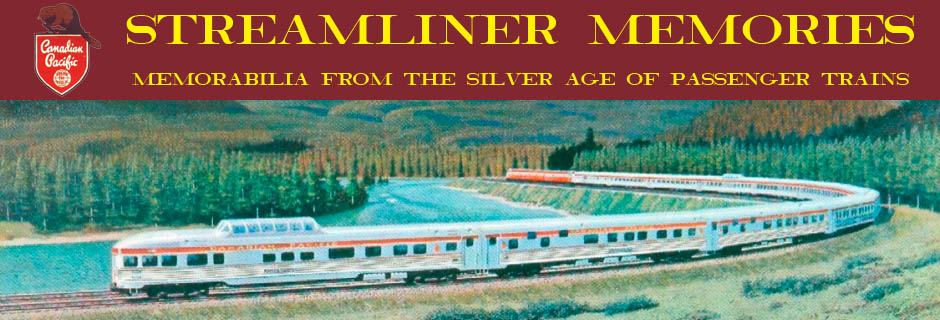In 1934, the Denver & Rio Grande Western had just completed the Dotsero Cutoff allowing its trains to go due west from Denver through the Moffat Tunnel and over the Denver & Salt Lake Railroad to Grand Junction and Salt Lake City. This timetable shows trains 5 & 6, the Panoramic, using this route. D&RGW did not fully acquire the Denver & Salt Lake until 1947.

Click image to download a 3.0-MB PDF of this four-panel timetable.
In the meantime, the Rio Grande still ran two round trips a day–numbers 1 & 2, the Scenic Limited and 15 and 16, the Colorado-New Mexico Express–between Denver and Grand Junction (with the Scenic Limited continuing to Salt Lake City) over the Royal Gorge Route. A train called the Westerner, numbers 3 and 4, also went from Denver to Pueblo, giving that portion of the route three round trips a day.

The route over Marshall Pass included many tight curves. Click image to see a much larger (4.4-MB) view.
The railroad still had two prominent narrow-gauge lines. First was the Marshall Pass-Black Canyon route from Salida to Montrose. Train 315–which, starting in 1937, was called the Shavano–left Salida, on the Royal Gorge line, at 7:15 am and arrived in Montrose at 2:40 pm. Through passengers could catch a standard-gauge train from there to Grand Junction, arriving at 6 pm. Returning, train 316 left Grand Junction at 12:20 pm and arrived at Salida at 11 pm. The westbound trains did not have a con convenient connection from Denver: passengers on the Colorado-New Mexico Express could layover at Salida from 2:40 am until 7:15 am, while eastbound passengers had only an hour layover, leaving Salida for Denver at 12:01 am.

Train number 315, not yet formally named the Shavano, near Gunnison on September 20, 1936. Click image for a larger view.
The other major narrow-gauge route went over La Veta Pass from Pueblo to Alamosa, Antonito, Chama, and Durango. This route was served by trains 115 and 116,which, starting in 1937, were called the the San Juan Express. Westbound passengers could take the Colorado-New Mexico Express from Denver to Pueblo, arriving at 10:50 pm. At 11:25 pm, train 115 left Pueblo and went over the pass, arriving in Durango at 4:35 pm. Returning, train 116 left Durango at 9:50 am, arriving Pueblo at the uncomfortable time of 3 am, allowing connection with the Colorado-New Mexico Express departing for Denver at 4 am. The timetable lists several trains from Durango, including a mixed train to Silverton and Rio Grande Southern trains to Farmington, Telluride, and Ridgeway.
Another pair of unnamed trains on the timetable were numbers 11 and 12, from Salt Lake City to Marysville, Utah via Thistle. Passenger service continued on this route into the early 1950s, and the line was only abandoned in 1984, when a landslide at Thistle obstructed the route.
